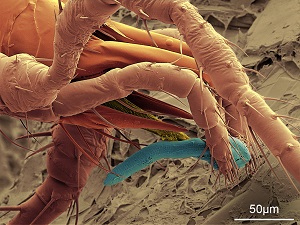Winners of the Photo & video contest on Soil Biodiversity
Akshara Samarasuriya from Sir Lanka and Eric Palesvky from Israel have won the Photo & video contest on Soil Biodiversity with their entries “Secret colony of termites under the soil” and “Soil predatory mite feeds on the nematode".
GSP received over 700 photos from 60 countries for the contest, bringing visibility to various organisms that spend 90 percent of their life underground. Launched in the run-up to GSOBI21, the soil biodiversity photo & video contest helped push the soil biodiversity agenda further to the public. It promoted and gave visibility to the importance of soil organisms and raised awareness on the urgency of protecting soil biodiversity. Furthermore, it created a broader engagement on the subject through various FAO-GSP social media platforms.
Five finalists were selected from both categories: mega & macrofauna and meso & microfauna. The shortlisted entries were posted on FAO’s main social media page for two-weeks public voting. In total, the entries received 6,866 likes, 726 comments, and 693 shares. Akshara Samarasuriya, category mega & macrofauna, received the most significant number of votes. Her incredible photo of a secret colony of termites under the soil, triggered 3000 likes, 332 comments, and 207 shares. Similarly, Eric Palesvky, category meso & microfauna, took a fantastic picture of a soil predatory mite feeds on a nematode, which received 599 likes, 29 comments, and 30 shares.
Congratulations to the winners and finalists and a big thank you to all participants.
Discover the FLICKR PHOTOGALLERY!
Mega and Macrofauna

©Akshara Samarasuriya, Sri Lanka
Secret colony of TERMITES under the soil. They help with soil aeration, redistribution of soil particles, repacking and more. Mainly, termites built their nests inside as well as on the soil. They decompose organic matter and use as their feed.
|
WOODLICE (Dayak Tomun) supporting decomposition for soil nutrient cycling. Not an insect, but a crustacean. Although tiny, it rolls into a tight ball when disturbed. |

©Sergii Dymchenko, United States
ARION RUFUS. Close-up of the head of a garden slug in Washington state.
|
EARTHWORMS feed on decomposing organic substances. Digging tunnels they allow better aeration and water circulation. They producee humus (their defection), natural fertilizer. |

©Alessandra Málory, Arrázola Céspedes, COLEOPTERA, Bolivia
Small beetles running against time on ancient and hot lands, life flows by creating soils at Toro Toro Archaeological National Park.
Meso and Microfauna

©Eric Palesvky, Israel
SOIL PREDATORY MITE feeds on the nematode. Their diverse diet makes them excellent candidates for biological control. Root-knot nematodes, MELOIDOGYNE, cause severe economic losses to many agricultural crops.
|
STRATIOLAELAPS SCRIMITUS. The best spaghetti in town: a cosmopolitan soil predatory mite phagocyting a nematode. Their diverse diet candidates them for biological control. |

©Felicity Crotty, United Kingdom
A predatory PSEUDOSCORPION in action. Pitfall trap sample included this Pseudoscorpion that had caught a Symphypleona Collembola, just before both fell to their death within the trap.
|
MACROBIOTUS SHONAICUS. Tardigrade in the reproductive process. This species, found from mosses grew at a Japan parking in 2018, is used to investigate distribution, ecology, genomics. |

©Sarah L. Bluhm, Germany
ALLACMA FUSCA (Collembola) on dead wood feeding on algae.
More on the photo & video contest on soil biodiversity here

